 |
|
|||
 |
 |
|||
Copyright © Harry Rinker, LLC 2016 Questions
and Answers
QUESTION: I have two sgrafitto redware plates from Breininger Pottery in Robesonia, Pennsylvania. The first is a square plate with chamfered corners and raised edges. The plate is approximately 10-inches across. The central design is a plant featuring three daisy-like flowers with a quatrefoil center design. Two raised edges have tulip designs and the other a leafed branch. The back is incised: “Breininger Pottery / Robesonia, PA / June 15, 1991 / Sunny, hot + / humid.” The second is a 9-inch diameter deep dish. The central motif is a vase holding three abstract flowers, each with six-pointed petals. The raised edge has a border featuring demi-lune groupings between an upper and lower incised line. The back is incised: “Breininger/ Pottery / Robesonia, PA / May 22, 1979 / Sunny + hot.” What is the value of my plates? –PK, Reading, PA, Email Question 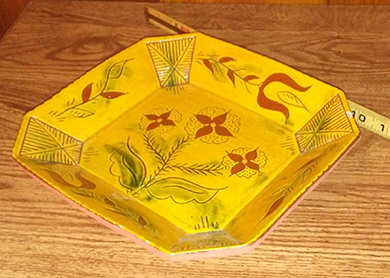
ANSWER: I first met Lester and Barbara Breininger in 1973, shortly after accepting the position as Executive Director of the Historical Society of York County [Pa]. The Society’s Gift Shop at the Golden Plough Tavern sold Breininger pottery. In addition, the Society commissioned Lester and Barbara to create a series of four plates, each plate incorporating an image from the Society’s Lewis Miller folk art drawing collection. In the ensuing years, I became friends with Lester and Barbara and enjoyed many wonderful visits to their home, the George Taylor Mansion in Robesonia, Pennsylvania. [Author’s Aside: Lester, a biology teacher at Conrad Weiser School District, and Barbara, a nurse, worked as a team. Lester gathered the clay and worked it, threw the forms, did the slip decoration, fired, and marketed the redware. Barbara did the sgrafitto decoration in the early years. Sgrafitto pieces marked “L + B Breininger” are highly sought after by collectors. Barbara’s involvement lessened as Breinnger Pottery evolved from an owner handcraft operation to a mass-production commercial enterprise.] 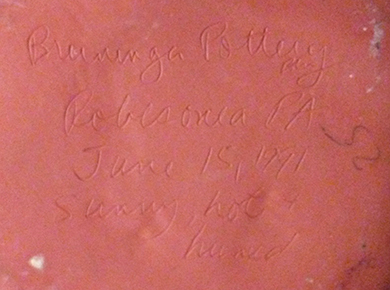
In the early 1970s leading up to the 1976 United States Bicentennial, Berks, Montgomery, and several eastern Pennsylvania counties were home to dozens of individuals who were committed to reviving the handcraft traditions of the Pennsylvania Germans. The revival was part of the “The Foxfire Movement.” Through my contact with the Breiningers, I met Dan (wood carver) and Barbara (folk painter) Strawser, Marge Yoder (theorem painter), Carroll (painted boxes) and Claudia (scherenschnitte) Hoff, and Thomas Stauffer (pewter). For several years, I volunteered my services to help them promote and market their products. It was a “heady” time. Lester Breininger considered himself the heir to a Pennsylvania redware tradition-- from the earliest German settlers in Pennsylvania to the 20th Century’s last of the wood-kiln fired redware manufacturers, such as Jacob Medinger and the Stahl family (Powder Valley, PA). Paul G. Locher’s “Collecting Breininger Pottery: From A to Z,” published by Breininger Publications, LLC. in 2013, is the definitive reference source. There is a strong secondary market for Breininger pottery, primarily located in New England and Mid-Atlantic states. Auction houses such as Alderfer (Hatfield, PA), Garth’s (Delaware, OH), Horst (Ephrata, PA), and Pook and Pook (Downingtown, PA) sell the high-end pieces. High-end means figural and sculptural pieces, large showy, often special commissioned, pieces, and early examples actually made start to finish by Lester or Lester and Barbara. Your two examples are mass-production pieces. Lester supervised the production. How much personal involvement he had in the creation of the pieces is questionable. From the beginning of his pottery making, Lester continued the tradition of Pennsylvania German redware potters of placing comments on the back about the weather or an event that occurred on or near the date the plate was decorated. Historically, Pennsylvania German redware potters did not date their wares. In checking WorthPoint.com, the online sale through price website, I found more than 2,053 listings for Breininger pottery. Examples with floral designs similar to those found on your two plates are very common. Based on comparable pieces found among the WorthPoint.com listings, the secondary market retail value of each plate is between $15.00 and $20.00, thus making them a difficult sell. QUESTION: I have two Cristallieries De Bayel 1976 Bicentennial Independence Hall glass plates. Each is accompanied by a certificate, one indicating the plate is Nr. 284 out of 500. I have searched all over and cannot find anyone or any place that knows what these plates are and their value. – PK, Email Question 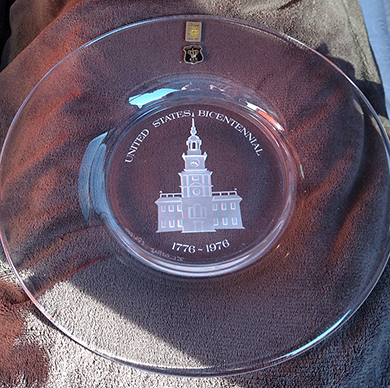
ANSWER: Bayel, a French commune in the Aube department in the Grand East region of north-central France, is noted for its crystal production. The earliest glass production dates to the early fourteenth century. In 1666, Venetian master glass blower Jean-Baptiste Mazzolay, came to Bayel. King Louis XIV named Bayel a royal manufacturer of crystal. Bayel developed a reputation for glass decorated with engraving, gilt, and enameling. Glass manufacturing continues. Bayel’s Museum of Crystal is a tourist attraction. Bayel’s rich history cannot disguise the mass-production aspect of your plate. An edition of 500 is not limited. The certificate of authenticity is questionable. The plate is one of a long list of collector edition items issued during the 1976 United States Centennial. The secondary market for this material is weak to non-existent. Most items sell for less than their initial purchase price. 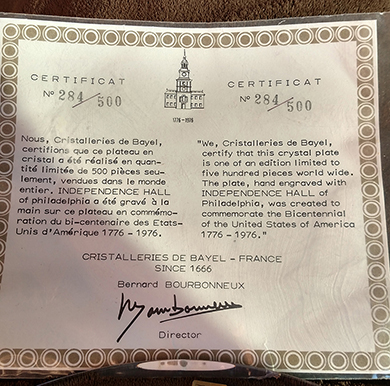
I located a March 2015 eBay listing by a Canadian seller for $80.00 plus shipping. This is an “only in your dreams” price. The seller was unduly optimistic. The plate did not sell. Reality suggests a secondary market retail value between $10.00 and $15.00. The value is unlikely to increase in July 2026, the 250th anniversary of the signing of the Declaration of Independence. New collector edition material will flow into the market resulting in continual minimal demand for older examples. QUESTION: Decades ago, I purchased a hand muff for $12.00 while traveling in Duluth, MN. It is a fun piece. I cannot imagine an era where a woman would be outside with her hands in a muff. Today, women wear mittens or gloves for driving, shoveling, and walking. I must note, the muff is “quite warm” inside. With frigidity temperatures in the forecast, maybe I will turn into a hand muff fan. – SS, Bozeman, MT, Email Question 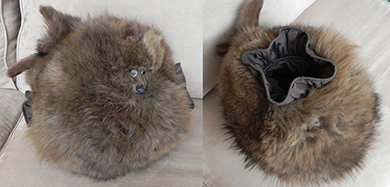
ANSWER: I remember my mother and her sisters using fur muffs in the late 1940s. Knowing little about the history of the fur muff, I researched the subject. Written descriptions of muffs date back to the fifteenth century. The first portrait of a woman with a muff was painted in 1588. At the time, muffs were used by men and women. Women preferred muffs made from ermine, sable, and grey squirrel. Men’s muffs were made from lynx, otter, or tiger. Women often substituted a muff for a purse. Muffs held a variety of small items in addition to the owner’s hands. A muff craze occurred at the end of the seventeenth century as fur from the Hudson Bay Company, founded in 1670, flowed into the market. In the early nineteenth century, John Jacob Astor’s The Pacific Fur Company became a major supplier of furs, especially to the American market. When fur coats became fashionable in the 1860s, muffs went out of fashion. Women placed their hands into their fur coat’s pockets. The advent of the automobile brought muffs back into fashion. Handbag use quickly replaced them. During World War II, muffs returned as a repurposing statement resulting from the reuse of old fur coats. When the war ended, the muff craze did as well. Since the 1950s, gloves and mittens are the standard cold weather hand covering for women. [See: https://en.wikipedia.org/wiki/Muff_(handwarmer); http://fashion-history.lovetoknow.com/fashion-accessories/muffs; and, http://www.astorplacevintage.com/history-fur-muffs] Fur muffs have limited secondary market value. The $12.00 you paid sill is a fair price in 2017. Three factors can impact price upward: (1) type of fur, (2) a designer label, and (3) a pre-1850 origin. Most muffs that meet one or more of these criteria are in museum textile collections. Harry L. Rinker welcomes questions from readers about
collectibles, those mass-produced items from the twentieth and twenty-first centuries.
Selected letters will be answered in this column.
Harry cannot provide personal answers.
Photos and other material submitted cannot be
returned.
Send your questions to: Rinker on Collectibles, 5955 Mill
Point Court SE, Kentwood, MI 49512.
You also can e-mail your questions to
harrylrinker@aol.com.
Only e-mails containing a full name and mailing address
will be considered.
You can listen
and participate in
WHATCHA GOT?, Harry’s
antiques and collectibles radio call-in show, on Sunday mornings between 8:00 AM
and 10:00 AM Eastern Time.
If you
cannot find it on a station in your area,
WHATCHA GOT?
streams live on the Internet at www.gcnlive.com.
SELL, KEEP OR TOSS?: HOW TO DOWNSIZE A HOME,
SETTLE AN ESTATE, AND APPRAISE PERSONAL PROPERTY
(House of Collectibles, an imprint of Random House Information Group, $17.99),
Harry’s latest book, is available at your favorite bookstore and via
www.harryrinker.com.
|
||||